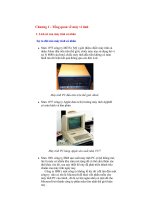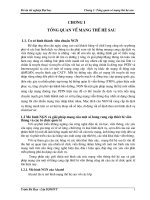Mineral classification 1
Bạn đang xem bản rút gọn của tài liệu. Xem và tải ngay bản đầy đủ của tài liệu tại đây (482.18 KB, 17 trang )
MINERAL CLASSIFICATION
How minerals are grouped
Classification
• Minerals are generally grouped or classified
based on their chemical composition.
• Most common system is the Dana system.
• Developed by Professor James Dana of
Yale University in 1848.
Mineral Composition
• Minerals are usually
compounds made of
the most common
elements in the crust
Silicates
The largest group of
minerals
Composed of:
Metal + SiO2
Example: topaz
Al2SiO4(F,OH)3
Carbonates
The second largest
group of minerals
Composed of:
Metal + CO3
Example: calcite
CaCO3
Oxides
Composed of:
Metal + O
Example: magnetite
Fe3O4
Sulfates
Composed of:
Metal + SO4
Example: barite
BaSO4
Halides
Composed of:
Metal + halogen
Halogens include:
Chlorine
Fluorine
Bromine
Iodine
CaF2
Example: fluorite
Sulfides
Composed of:
Metal + S
Example: chalcocite
Cu2S
Phosphates
Composed of:
Metal + PO4
Example: Apatite
Ca5(PO4)3(OH,F,Cl)
Nitrates
Composed of:
Metal + NO3
Example: Niter
KNO3
Native Elements
Composed of:
A single element
Example: Gold
Au
Instructions:
Place the names of the mineral groups across the top of your desk.
Place the minerals in the correct column based on the chemistry.
Here are the correct results
Native Elements
Silicates
Oxides
Halides
Phosphates
Apatite: Ca5(F,Cl,OH)(PO4)3
Gold: Au
Beryl: Be3Al2(Si6O18)
Chromite: FeCr2O4
Cryolite: Na3AlF6
Silver: Ag
Talc: Mg3(Si4O10)(OH)2
Corundum: Al2O3
Halite: NaCl
Copper: Cu
Orthoclase: KAlSi3O8
Hematite: Fe2O3
Fluorite: CaF2
Sulfur: S
Muscovite: KAl2(AlSi3O10)(OH)2
Magnetite: Fe3O4
Sylvite: KCl
Quartz: SiO2
Ilmenite: FeTiO3
Kaolinite: Al4(Si4O10)(OH)8
Rutile: TiO2
Carbonates
Sulfates
Sulfides
Nitrates
Calcite: CaCO3
Gypsum: CaSO4.2H2O
Galena: PbS
Niter: KNO3
Dolomite: CaMg(CO3)2
Barite: BaSO4
Sphalerite: ZnS
Siderite: FeCO3
Anhydrite: CaSO4
Pyrite: FeS2
Malachite: Cu2CO3(OH)2
Epsomite: MgSO4.7H2O
Bornite: Cu5FeS4
Turquoise: CuAl6(PO4)4(OH)8.2H2O
Lazulite: MgAl2(OH)2(PO4)2
Directions on how to print the next slide for classroom use:
1.Follow these steps to print a copy of the mineral labels used by students in this activity.
2.Duplicate the sheet and cut along the lines.
3.Select “Print Preview” option on print menu.
4.Select “slides” on Print What menu.
5.Select “Print” on print menu.
6.Choose page 17 to print and on the Options menu choose “black and white”.
Native Elements
Gold: Au
Silver: Ag
Copper: Cu
Silicates
Beryl: Be3Al2(Si6O18)
Muscovite: KAl2(AlSi3O10)(OH)2
Talc: Mg3(Si4O10)(OH)2
Oxides
Corundum: Al2O3
Hematite: Fe2O3
Magnetite: Fe3O4
Carbonates
Calcite: CaCO3
Dolomite: CaMg(CO3)2
Halides
Halite: NaCl
Fluorite: CaF2
Sylvite: KCl
Sulfates
Barite: BaSO4
Gypsum: CaSO4.2H2O
Anhydrite: CaSO4
Sulfides
Galena: PbS
Sphalerite: ZnS
Pyrite: FeS2
Nitrates
Niter: KNO3
Phosphates
Apatite: Ca5(F,Cl,OH)(PO4)3
Turquoise: CuAl6(PO4)4(OH)8.2H2O
Lazulite: MgAl2(OH)2(PO4)2
Quartz: SiO2
Orthoclase: KAlSi3O8
Kaolinite: Al4(Si4O10)(OH)8
Ilmenite: FeTiO3
Rutile: TiO2
Chromite: FeCr2O4
Siderite: FeCO3
Malachite: Cu 2CO3(OH)2
Sulfur: S
Cryolite: Na3AlF6
Epsomite: MgSO4.7H2O
Bornite: Cu5FeS4









